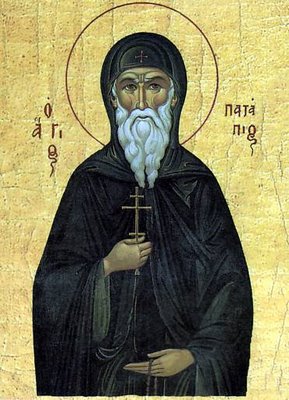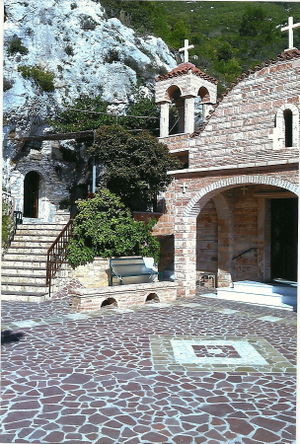Patapius of Thebes

Our venerable and God-bearing father Patapius of Thebes was born in Thebes of Egypt and lived in the Kemetian desert sometime during the fourth century. His holy relics have been found incorrupt and can be venerated to this present day. St. Patapius in the Syriac church is venerated as a patron saint of people who have dropsy. The Church celebrates his memory December 8.
Contents
[hide]History
Saint Patapius was born in 380 in the Egyptian city of Thebes. His father was a governor of the region and a descendant of a well known Egyptian family. He and his wife were devout Christians and instructed Patapius in Scripture. As Patapius reached a mature age, well-known tutors were brought from Alexandria to instruct him in science, mathematics, philosophy and rhetoric. Through this education, he became accutely aware of how transient this world is and was attracted to the ascetical way of life. He was particularly inspired by Clement, Origen and Athanasius. His father also took him to the renowned catechetical school in Alexandria where Patapius came under the influence of a blind teacher named Didemus [1]. Didemus inspired him even further to desire the ascetical path he had chosen. When he finished his studies, he returned to Thebes to find out that his father had passed away. Desiring to live a life like the ascetics, he decided to leave for the Egyptian desert where he became well known for his ascetic deeds.
No longer able to find peace in the desert he set off for Constantinople in 428. During his voyage, he met his disciple Sechnuti, who was an Egyptian rower. [During this voyage, their ship passed near Corinth where they stayed for seven years]
By 435, after seven years in Corinth, Patapius left his skete in the Geranian mountains to resume his journey to Constantinople taking with him the monk Sechnuti. In Constantinople, they secretly went to the Monastery of Blachernae, where he obtained a cell in the city wall. Patapius kept his identity a secret and resumed a life of strict fasting, vigil and prayer under the guise of a simple monk.
Here he performed many miracles of healing. After a life adorned with virtue and miracles, he died at a great age of eighty-three (83) in 463 and was buried by his disciples in the church of St. John the Baptist in Constaninople of Petras (of Stone) which was under the protection of the royal family of Constantinople, Palaiologoi, and especially of Saint Hipomoni (Saint Patience) who was the mother of the last emperor of Byzantium, Constantine Palaiologos.
Since the saint's repose, the Church has carefully preserved the stories of his life and his sacred relics. One thousand years after the repose of the saint, when the Turks captured Constantinople, his relics where removed and taken to the little cave-skete in Corinth (as he had requested during his lifetime). The saint's body was hidden behind a western wall in the cave facing the iconostasis and chapel they built.
In the early 20th-century a local priest[2] discovered the relics of the saint hidden in the wall. He was an unnaturally tall priest who regularly served this small chapel and because of his height commissioned some changes to the chapel. The night before the works to the western wall were to commence, Fr. Constantine had a dream in which a monk warned him to "take care when you break the wall because I am on the other side. I am Saint Patapius of Egypt." He was found the next day holding a large wooden cross on his chest, a parchment scroll with his identity and large leaves covering his relics as fresh as they had been picked that very moment.
Since his relics have been discovered, many people have been visited by the saint in visions and dreams asking them to visit "his house in Loutraki". He is especially known for healing cancer and miracles occur world-wide throughout the world, including Australia and America.
Monastery of St. Patapios
- See Main Article: Monastery of St. Patapius in Loutraki, Greece
His relics was brought to the Geraneia mountains, in the Gulf of Corinth, by ascetics from Constantinople and sealed in a cave. In 1904, the relics were discovered when the cave was opened. The saint's body had been placed beneath tiles and large leaves, to protect it from the damp, and it exuded a sweet odour. On the relic was a scroll giving Patapius's name, with a wooden cross and some Byzantine coins. However some visitors of the cave took pieces of the Saints’ relics for an amulet! But in many of them the Saint came on their dreams and asked them to return his pieces to the nunnery. So they did.
Then a priest from Loutraki, Father Konstantinos Sousanis, took the relic of Saint Patapius from the cave and kept it, with the church’s permission, to his house in Loutraki, in order to keep it away from the vandals. Later, on 1952, Father Nectarios Marmarinos, a priest from Soinikismos of Corinth, established at the place of the cave in which St. Patapius was found a monastery and the relic was returned to the cave.
The first mother superior, on 1952, was nun Siglitiki. Nun patapia was the next mother superior from 1963 to 1970, when she resigned because of health problems. She helped very much at the building of the monastery. The next, and current, mother Superior is sister Isidora.
Saint Patapius’ memory is celebrated on December 8 (main celebration) and also at the Tuesday two days after the Pascha Sunday (in memory of the day that his relic was discovered). The Saint has done many meracles and helped many people with diseases, family and personal problems. The monastery of St. Patapius is at Loutraki, a spa city, one hour from Athens, the capital of Greece. The holy relic is now in a special wooden structure at the back of the cave.
Hymns and Troparia
Troparion in Tone 8
- The image of God was truly preserved in you, O Father,
- for you took up the Cross and followed Christ.
- By so doing you taught us to disregard the flesh for it passes away
- but to care instead for the soul, since it is immortal.
- Therefore your spirit, venerable Patápius, rejoices with the angels.
Kontakion in Tone 3
- Your temple is found to be a source of healing,
- and the people flock to it eagerly, O saint.
- They seek the healing of their diseases and the forgiveness of their sins,
- for you are a protector for all those in need, venerable Patápius.
See also
Notes
- Jump up ↑ This is the Didemus who St. Anthony the Great said, "Do not mourn that you are deprived of physical eyes, they are only good for the flies and mosquitos. You should rejoice that you have the eyes of the soul and that your inner sight has been opened to divine and heavenly beauty."
- Jump up ↑ Father Constantine Sosanis
Reference
- «The Holy Monastery of Saint Patapios in Loutraki» [edition of the Metropolis of Corinth, Sikyon, Zemenou, Tarsus and Polyfengous, 2012].
- «The Greek Monasteries» [Ev. Lekkou, Ihnilatis, Athens, 1995].
- "Agiologio of Orthodoxy," [Christos Tsolakidis, Athens, 2001 edition]
- «O Megas Synaxaristis of the Orthodox Church" Saint Patapios, p. (254) - (261) [m Victoras Mattheos, 3rd edition, Metamorfosi Sotiros Monastery, Athens, 1968]
- "Saint Patapios" [Stylianos Papadopoulos, professor of the University of Athens, Holy Monastery of Saint Patapios, Loutraki, Greece, edition 2006).
- "St. Patapios and his miracles," [Dr. Charalambos Busias, edition of Holy Monastery of Saint Patapios Loutraki 2004]
- "Life, akolouthia, paraklitikos kanonas and egomia of the holy mother ‘’Saint Hypomone" [Dr. Charalambos Busias, edition of Holy Monastery of Saint Patapios, Loutraki 1999]
- "Deltos of Miracles of our miraculous father St. Patapios" [Dr. Charalambos Busias, edition of Holy Monastery of Saint Patapios 4th Edition, Loutraki 2011]
External links
- http://www.imkorinthou.org/index.php?option=com_content&view=article&id=41&Itemid=139
- Monastery of St Patapios (Loutraki, Greece)
- Saint Patapios: his life, his miracles and his monastery
- Saint Patapios of Thebes and His Monastery in Loutraki
- Nunnery of Hosios Patapios
- A Miracle and the Life of St. Patapios of Thebes
- Saint Patapios Panorama
- http://www.livepedia.gr/index.php/%CE%93%CE%AD%CF%81%CE%BF%CE%BD%CF%84%CE%B1%CF%82_%CE%9D%CE%B5%CE%BA%CF%84%CE%AC%CF%81%CE%B9%CE%BF%CF%82_%CE%9C%CE%B1%CF%81%CE%BC%CE%B1%CF%81%CE%B9%CE%BD%CF%8C%CF%82
- http://www.livepedia.gr/index.php/%CE%93%CE%B5%CF%81%CF%8C%CE%BD%CF%84%CE%B9%CF%83%CF%83%CE%B1_%CE%A0%CE%B1%CF%84%CE%B1%CF%80%CE%AF%CE%B1
- http://www.facebook.com/pages/Sister-Patapia/109137369163998#!/pages/Sister-Patapia/109137369163998?sk=info
- http://www.youtube.com/watch?v=WO6mGl_j2Qc
- Wikipedia:Saint Patapios
In Greek
- Άγιος Πατάπιος. Βικιπαίδεια.
- Great Synaxaristes: (Greek)
Ὁ Ὅσιος Πατάπιος. 8 Δεκεμβρίου. ΜΕΓΑΣ ΣΥΝΑΞΑΡΙΣΤΗΣ.
Categories > Church History
Categories > Church History
Categories > Church History
Categories > Church History
Categories > Church History
Categories > Liturgics > Feasts
Categories > Liturgics > Feasts
Categories > Liturgics > Feasts
Categories > Liturgics > Feasts
Categories > Liturgics > Feasts
Categories > People > Monastics
Categories > People > Saints
Categories > People > Saints > Byzantine Saints
Categories > People > Saints > Egyptian Saints
Categories > People > Saints > Greek Saints
Categories > People > Saints > Saints by century > 5th-century saints





